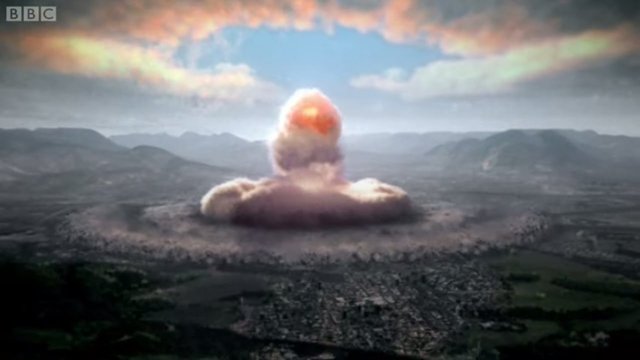Attacks from Hiroshima and Nagasaki
Attacks from Hiroshima and Nagasaki
In August 1945, there were the terrible atomic attacks in Japan. These consisted of throwing two nuclear bombs produced in the US at the end of the Second World War over two Japanese cities: Hiroshima and Nagasaki.
At that time, though the war in Europe ended with the unconditional surrender of Nazi Germany, Japan and the United States were still in a state of war.
Thus, on August 6, 1945, the atomic bomb, known as Litlle Boy, was thrown over Hiroshima. At a distance of only three days, on August 9, 1945, a second atomic bomb was thrown over Nagasaki. This second bomb Atomic was called Fat Man.
The two atomic weapons were practically weapons of mass destruction, causing shock and terror. The number of victims in the two nuclear-armed cities of Shiroshima and Nagasachi has never been accurately communicated. In some reports, the number of victims is estimated to be between 129,000 and 240,000. Other opinions say that the number of these victims would be much higher, at least double. Nuclear weapons are the most powerful explosives ever created by humans. They are divided into two categories: fission, or "atomic" bombs, and fusion, those called "hydrogen" or "thermonuclear" weapons. The destructive power of an atomic bomb originates in the sudden release of energy created by nuclear fission. In fission guns, matter is transformed into energy when the nucleus of an atom is broken. By breaking the nucleus, sub-atomic neutrons are released, which will collide and break other nuclei of atoms. This is the chain reaction, thanks to which nuclear weapons have so much power as regular weapons.
Shortly after the launch of the first atomic bomb, Litlle Boy, on the Japanese Hiroshima, the then US President, Harry S. Truman, demanded Japan's surrender, just 16 hours after the launch of the atomic bomb on Hiroshima.
When Japan refused the surrender request, President Truman ordered the launch of the second atomic bomb against the Japanese people.
The launch of the two atomic bombs in Japan was motivated by the fascist capitulation of the former Allies of Nazi Germany. The latter were simply shocked and terrorized by the impact of the atomic attack on their country.
Unfortunately, the wars have never been in fair history, and in this case the impact of the civilian population has reached unimaginable thresholds. In fact, half of the victims were recorded only a few hours after the launch of the Litlle Boy atom bomb, on August 6, 1945 Hiroshima.
The other victims were recorded during the months and years ahead, here talking about the second half of the total number of victims. The vast majority of victims died from burns, radiation, and cancer. A disastrous consequence was the long-term effects of this event, and in 1945 no one knew whether they had an impact on the environment or on the population. However, the response was extremely tough: the consequences strongly affected people.
In the years to come, cities became a target of leukemia, which was the longest-lasting effect, reaching its peak in 1950. It also increased the risk of other types of cancer including thyroid, lung cancer and cancer Of breast. The first case of thyroid cancer was made public only in 1957, lung cancer was correlated with the atomic explosion since the early 1950s, and in 1972 it was estimated that around 3,800 people died of this Type of cancer. As for breast cancer, women aged between 22 and 30 are the most likely.
It has been estimated that the risk of cancer in the case of a person who has been exposed to these radiation is three times higher than in the case of one who has not come into contact with them.
The explosive power of nuclear weapons is measured in kilotons or megatons. One kiloton equals the explosive force of 1,000 tons of TNT. A megatone means the power of 1 million tons of TNT. The atomic bomb at Hiroshima produced a 15-kiloton explosion. With hydrogen or fusion, the bombs have so far produced explosions reaching up to 60 megatons.
The destructive force of nuclear weapons is not limited to the intensity of the explosion. Shock waves propagate from the detonation site at an incredible speed and force so great that they can destroy the buildings in their path. Thermal radiation, dazzling light and extreme heat emanating from the explosion cause fatal burns. Some scientists have come to the conclusion that during a nuclear war, the smoke emitted by a series of explosions would cover the entire atmosphere, causing the so-called "nuclear winter" that would cause temperatures to drop so much that most life forms would Be destroyed. Nuclear explosions also cause radioactive radiation that can remain in the atmosphere and in the environment for many years.
As I said above, we do not consider these two attacks on the Japanese civilian population to be fair. How do we not know if the effects of these atomic attacks still exist on the earth globe, even after the 70 years' .
Theoretically and practically there is always fear induced throughout humanity that these attacks might once again be repeated.
That's why the huge sums allocated to the Aram during the Cold War on both belligerent, East and West.
Let's hope that mankind will never have such attacks.
I am new at Steemit. Its a great community.
I 'm friendly minded.
I need help to grow up this community.
Any one follow me @rsrb and inform me I also follow you.
Thanks